Target Information
| Target General Information | Top | |||||
|---|---|---|---|---|---|---|
| Target ID |
T24793
(Former ID: TTDR00620)
|
|||||
| Target Name |
Voltage-gated calcium channel alpha Cav1.3 (CACNA1D)
|
|||||
| Synonyms |
Voltage-gated calcium channel alpha subunit Cav1.3; Voltage-gated L-type Ca2+ channel alpha1D; Calcium channel, L type, alpha-1 polypeptide, isoform 2; CACNA1D
Click to Show/Hide
|
|||||
| Gene Name |
CACNA1D
|
|||||
| Target Type |
Clinical trial target
|
[1] | ||||
| Disease | [+] 1 Target-related Diseases | + | ||||
| 1 | Alzheimer disease [ICD-11: 8A20] | |||||
| Function |
Voltage-sensitive calcium channels (VSCC) mediate the entry of calcium ions into excitable cells and are also involved in a variety of calcium-dependent processes, including muscle contraction, hormone or neurotransmitter release, gene expression, cell motility, cell division and cell death. The isoform alpha-1D gives rise to L-type calcium currents. Long-lasting (L-type) calcium channels belong to the 'high-voltage activated' (HVA) group. They are blocked by dihydropyridines (DHP), phenylalkylamines, benzothiazepines, and by omega-agatoxin-IIIA (omega-Aga-IIIA). They are however insensitive to omega-conotoxin- GVIA (omega-CTx-GVIA) and omega-agatoxin-IVA (omega-Aga-IVA).
Click to Show/Hide
|
|||||
| BioChemical Class |
Voltage-gated ion channel
|
|||||
| UniProt ID | ||||||
| Sequence |
MMMMMMMKKMQHQRQQQADHANEANYARGTRLPLSGEGPTSQPNSSKQTVLSWQAAIDAA
RQAKAAQTMSTSAPPPVGSLSQRKRQQYAKSKKQGNSSNSRPARALFCLSLNNPIRRACI SIVEWKPFDIFILLAIFANCVALAIYIPFPEDDSNSTNHNLEKVEYAFLIIFTVETFLKI IAYGLLLHPNAYVRNGWNLLDFVIVIVGLFSVILEQLTKETEGGNHSSGKSGGFDVKALR AFRVLRPLRLVSGVPSLQVVLNSIIKAMVPLLHIALLVLFVIIIYAIIGLELFIGKMHKT CFFADSDIVAEEDPAPCAFSGNGRQCTANGTECRSGWVGPNGGITNFDNFAFAMLTVFQC ITMEGWTDVLYWMNDAMGFELPWVYFVSLVIFGSFFVLNLVLGVLSGEFSKEREKAKARG DFQKLREKQQLEEDLKGYLDWITQAEDIDPENEEEGGEEGKRNTSMPTSETESVNTENVS GEGENRGCCGSLCQAISKSKLSRRWRRWNRFNRRRCRAAVKSVTFYWLVIVLVFLNTLTI SSEHYNQPDWLTQIQDIANKVLLALFTCEMLVKMYSLGLQAYFVSLFNRFDCFVVCGGIT ETILVELEIMSPLGISVFRCVRLLRIFKVTRHWTSLSNLVASLLNSMKSIASLLLLLFLF IIIFSLLGMQLFGGKFNFDETQTKRSTFDNFPQALLTVFQILTGEDWNAVMYDGIMAYGG PSSSGMIVCIYFIILFICGNYILLNVFLAIAVDNLADAESLNTAQKEEAEEKERKKIARK ESLENKKNNKPEVNQIANSDNKVTIDDYREEDEDKDPYPPCDVPVGEEEEEEEEDEPEVP AGPRPRRISELNMKEKIAPIPEGSAFFILSKTNPIRVGCHKLINHHIFTNLILVFIMLSS AALAAEDPIRSHSFRNTILGYFDYAFTAIFTVEILLKMTTFGAFLHKGAFCRNYFNLLDM LVVGVSLVSFGIQSSAISVVKILRVLRVLRPLRAINRAKGLKHVVQCVFVAIRTIGNIMI VTTLLQFMFACIGVQLFKGKFYRCTDEAKSNPEECRGLFILYKDGDVDSPVVRERIWQNS DFNFDNVLSAMMALFTVSTFEGWPALLYKAIDSNGENIGPIYNHRVEISIFFIIYIIIVA FFMMNIFVGFVIVTFQEQGEKEYKNCELDKNQRQCVEYALKARPLRRYIPKNPYQYKFWY VVNSSPFEYMMFVLIMLNTLCLAMQHYEQSKMFNDAMDILNMVFTGVFTVEMVLKVIAFK PKGYFSDAWNTFDSLIVIGSIIDVALSEADPTESENVPVPTATPGNSEESNRISITFFRL FRVMRLVKLLSRGEGIRTLLWTFIKSFQALPYVALLIAMLFFIYAVIGMQMFGKVAMRDN NQINRNNNFQTFPQAVLLLFRCATGEAWQEIMLACLPGKLCDPESDYNPGEEYTCGSNFA IVYFISFYMLCAFLIINLFVAVIMDNFDYLTRDWSILGPHHLDEFKRIWSEYDPEAKGRI KHLDVVTLLRRIQPPLGFGKLCPHRVACKRLVAMNMPLNSDGTVMFNATLFALVRTALKI KTEGNLEQANEELRAVIKKIWKKTSMKLLDQVVPPAGDDEVTVGKFYATFLIQDYFRKFK KRKEQGLVGKYPAKNTTIALQAGLRTLHDIGPEIRRAISCDLQDDEPEETKREEEDDVFK RNGALLGNHVNHVNSDRRDSLQQTNTTHRPLHVQRPSIPPASDTEKPLFPPAGNSVCHNH HNHNSIGKQVPTSTNANLNNANMSKAAHGKRPSIGNLEHVSENGHHSSHKHDREPQRRSS VKRTRYYETYIRSDSGDEQLPTICREDPEIHGYFRDPHCLGEQEYFSSEECYEDDSSPTW SRQNYGYYSRYPGRNIDSERPRGYHHPQGFLEDDDSPVCYDSRRSPRRRLLPPTPASHRR SSFNFECLRRQSSQEEVPSSPIFPHRTALPLHLMQQQIMAVAGLDSSKAQKYSPSHSTRS WATPPATPPYRDWTPCYTPLIQVEQSEALDQVNGSLPSLHRSSWYTDEPDISYRTFTPAS LTVPSSFRNKNSDKQRSADSLVEAVLISEGLGRYARDPKFVSATKHEIADACDLTIDEME SAASTLLNGNVRPRANGDVGPLSHRQDYELQDFGPGYSDEEPDPGRDEEDLADEMICITT L Click to Show/Hide
|
|||||
| 3D Structure | Click to Show 3D Structure of This Target | AlphaFold | ||||
| Drugs and Modes of Action | Top | |||||
|---|---|---|---|---|---|---|
| Clinical Trial Drug(s) | [+] 1 Clinical Trial Drugs | + | ||||
| 1 | ARC029 | Drug Info | Phase 3 | Alzheimer disease | [2] | |
| Discontinued Drug(s) | [+] 3 Discontinued Drugs | + | ||||
| 1 | SIPATRIGINE | Drug Info | Discontinued in Phase 2 | Neurological disorder | [3] | |
| 2 | SNAP-5089 | Drug Info | Terminated | Heart arrhythmia | [4], [5] | |
| 3 | TH-9229 | Drug Info | Terminated | Reperfusion injury | [6] | |
| Mode of Action | [+] 4 Modes of Action | + | ||||
| Inhibitor | [+] 8 Inhibitor drugs | + | ||||
| 1 | ARC029 | Drug Info | [1] | |||
| 2 | SIPATRIGINE | Drug Info | [7] | |||
| 3 | CGS-27830 | Drug Info | [8] | |||
| 4 | SNAP-5089 | Drug Info | [9] | |||
| 5 | CV-4093 | Drug Info | [1] | |||
| 6 | MEBUDIPINE | Drug Info | [13] | |||
| 7 | N,N'-Di-acenaphthen-5-yl-guanidine | Drug Info | [7] | |||
| 8 | PD-32577 | Drug Info | [14] | |||
| Modulator | [+] 2 Modulator drugs | + | ||||
| 1 | TH-9229 | Drug Info | [10] | |||
| 2 | CPU-228 | Drug Info | [11] | |||
| Activator | [+] 1 Activator drugs | + | ||||
| 1 | (-)-(S)-BayK8644 | Drug Info | [11] | |||
| Inhibitor (gating inhibitor) | [+] 2 Inhibitor (gating inhibitor) drugs | + | ||||
| 1 | azidopine | Drug Info | [12] | |||
| 2 | [3H](+)-isradipine | Drug Info | [15] | |||
| Cell-based Target Expression Variations | Top | |||||
|---|---|---|---|---|---|---|
| Cell-based Target Expression Variations | ||||||
| Drug Binding Sites of Target | Top | |||||
|---|---|---|---|---|---|---|
| Ligand Name: Cinnarizine | Ligand Info | |||||
| Structure Description | Human L-type voltage-gated calcium channel Cav1.3 in the presence of cinnarizine at 3.1 Angstrom resolution | PDB:7UHF | ||||
| Method | Electron microscopy | Resolution | 3.10 Å | Mutation | No | [16] |
| PDB Sequence |
SIVEWKPFDI
130 FILLAIFANC140 VALAIYIPFP150 EDDSNSTNHN160 LEKVEYAFLI170 IFTVETFLKI 180 IYVRNGWNLL200 DFVIVIVGLF210 SVILEQLTDV236 KALRAFRVLR246 PLRLVSGVPS 256 LQVVLNSIIK266 AMVPLLHIAL276 LVLFVIIIYA286 IIGLELFIGK296 MHKTCFFADS 306 DIVAEEDPAP316 CAFSGNGRQC326 TANGTECRSG336 WVGPNGGITN346 FDNFAFAMLT 356 VFQCITMEGW366 TDVLYWMNDA376 MGFELPWVYF386 VSLVIFGSFF396 VLNLVLGVLS 406 GEFSKEREKA416 KARGDFQKLR426 EKQQLEEDLK436 GYLDWITQAE446 DCRAAVKSVT 524 FYWLVIVLVF534 LNTLTISSEH544 YNQPDWLTQI554 QDIANKVLLA564 LFTCEMLVKM 574 YSLGLQAYFV584 SLFNRFDCFV594 VCGGITETIL604 VELEIMSPLG614 ISVFRCVRLL 624 RIFKVTRHWT634 SLSNLVASLL644 NSMKSIASLL654 LLLFLFIIIF664 SLLGMQLFGG 674 KFNFDETQTK684 RSTFDNFPQA694 LLTVFQILTG704 EDWNAVMYDG714 IMAYGGPSSS 724 GMIVCIYFII734 LFICGNYILL744 NVFLAIAVDN754 LADAESLNTA764 QKEEAEEKIR 876 VGCHKLINHH886 IFTNLILVFI896 MLSSAALAAE906 DPIRSHSFRN916 TILGYFDYAF 926 TAIFTVEILL936 KMTTFGNYFN956 LLDMLVVGVS966 LVSFVVKILR984 VLRVLRPLRA 994 INRAKGLKHV1004 VQCVFVAIRT1014 IGNIMIVTTL1024 LQFMFACIGV1034 QLFKGKFYRC 1044 TDEAKSNPEE1054 CRGLFILYKD1064 GDVDSPVVRE1074 RIWQNSDFNF1084 DNVLSAMMAL 1094 FTVSTFEGWP1104 ALLYKAIDSN1114 GENIGPIYNH1124 RVEISIFFII1134 YIIIVAFFMM 1144 NIFVGFVIVT1154 FQEQGEKEYK1164 NCELDKNQRQ1174 CVEYALKARP1184 LRRYIPKNPY 1194 QYKFWYVVNS1204 SPFEYMMFVL1214 IMLNTLCLAM1224 QHYEQSKMFN1234 DAMDILNMVF 1244 TGVFTVEMVL1254 KVIAFKPKGY1264 FSDAWNTFDS1274 LIVIGSIIDV1284 ALSESITFFR 1319 LFRVMRLVKL1329 LSRGEGIRTL1339 LWTFIKSFQA1349 LPYVALLIAM1359 LFFIYAVIGM 1369 QMFGKVAMRD1379 NNQINRNNNF1389 QTFPQAVLLL1399 FRCATGEAWQ1409 EIMLACLPGK 1419 LCDPESDYNP1429 GEEYTCGSNF1439 AIVYFISFYM1449 LCAFLIINLF1459 VAVIMDNFDY 1469 LTRDWSILGP1479 HHLDEFKRIW1489 SEYDPEAKGR1499 IKHLDVVTLL1509 RRIQPPLGFG 1519 KLCPHRVACK1529 RLVAMNMPLN1539 SDGTVMFNAT1549 LFALVRTALK1559 IKTEGNLEQA 1569 NEELRAVIKK1579 IWKKTSMKLL1589
|
|||||
|
|
THR362
4.927
MET363
4.186
PHE699
3.837
LEU702
3.532
THR703
3.495
GLY704
4.861
PHE736
4.812
ASN740
3.390
LEU743
3.509
LEU744
3.565
PHE747
3.828
|
|||||
| Ligand Name: Cholesterol | Ligand Info | |||||
| Structure Description | Human L-type voltage-gated calcium channel Cav1.3 at 3.0 Angstrom resolution | PDB:7UHG | ||||
| Method | Electron microscopy | Resolution | 3.00 Å | Mutation | No | [16] |
| PDB Sequence |
SIVEWKPFDI
130 FILLAIFANC140 VALAIYIPFP150 EDDSNSTNHN160 LEKVEYAFLI170 IFTVETFLKI 180 IYVRNGWNLL200 DFVIVIVGLF210 SVILEQLTDV236 KALRAFRVLR246 PLRLVSGVPS 256 LQVVLNSIIK266 AMVPLLHIAL276 LVLFVIIIYA286 IIGLELFIGK296 MHKTCFFADS 306 DIVAEEDPAP316 CAFSGNGRQC326 TANGTECRSG336 WVGPNGGITN346 FDNFAFAMLT 356 VFQCITMEGW366 TDVLYWMNDA376 MGFELPWVYF386 VSLVIFGSFF396 VLNLVLGVLS 406 GEFSKEREKA416 KARGDFQKLR426 EKQQLEEDLK436 GYLDWITQAE446 DCRAAVKSVT 524 FYWLVIVLVF534 LNTLTISSEH544 YNQPDWLTQI554 QDIANKVLLA564 LFTCEMLVKM 574 YSLGLQAYFV584 SLFNRFDCFV594 VCGGITETIL604 VELEIMSPLG614 ISVFRCVRLL 624 RIFKVTRHWT634 SLSNLVASLL644 NSMKSIASLL654 LLLFLFIIIF664 SLLGMQLFGG 674 KFNFDETQTK684 RSTFDNFPQA694 LLTVFQILTG704 EDWNAVMYDG714 IMAYGGPSSS 724 GMIVCIYFII734 LFICGNYILL744 NVFLAIAVDN754 LADAESLNTA764 QKEEAEEKIR 876 VGCHKLINHH886 IFTNLILVFI896 MLSSAALAAE906 DPIRSHSFRN916 TILGYFDYAF 926 TAIFTVEILL936 KMTTFGNYFN956 LLDMLVVGVS966 LVSFVVKILR984 VLRVLRPLRA 994 INRAKGLKHV1004 VQCVFVAIRT1014 IGNIMIVTTL1024 LQFMFACIGV1034 QLFKGKFYRC 1044 TDEAKSNPEE1054 CRGLFILYKD1064 GDVDSPVVRE1074 RIWQNSDFNF1084 DNVLSAMMAL 1094 FTVSTFEGWP1104 ALLYKAIDSN1114 GENIGPIYNH1124 RVEISIFFII1134 YIIIVAFFMM 1144 NIFVGFVIVT1154 FQEQGEKEYK1164 NCELDKNQRQ1174 CVEYALKARP1184 LRRYIPKNPY 1194 QYKFWYVVNS1204 SPFEYMMFVL1214 IMLNTLCLAM1224 QHYEQSKMFN1234 DAMDILNMVF 1244 TGVFTVEMVL1254 KVIAFKPKGY1264 FSDAWNTFDS1274 LIVIGSIIDV1284 ALSESITFFR 1319 LFRVMRLVKL1329 LSRGEGIRTL1339 LWTFIKSFQA1349 LPYVALLIAM1359 LFFIYAVIGM 1369 QMFGKVAMRD1379 NNQINRNNNF1389 QTFPQAVLLL1399 FRCATGEAWQ1409 EIMLACLPGK 1419 LCDPESDYNP1429 GEEYTCGSNF1439 AIVYFISFYM1449 LCAFLIINLF1459 VAVIMDNFDY 1469 LTRDWSILGP1479 HHLDEFKRIW1489 SEYDPEAKGR1499 IKHLDVVTLL1509 RRIQPPLGFG 1519 KLCPHRVACK1529 RLVAMNMPLN1539 SDGTVMFNAT1549 LFALVRTALK1559 IKTEGNLEQA 1569 NEELRAVIKK1579 IWKKTSMKLL1589
|
|||||
|
|
PHE534
3.815
THR537
4.162
LEU538
3.726
SER541
3.292
SER542
3.880
HIS544
3.582
LEU898
3.634
ALA901
4.761
ALA902
3.732
ALA905
4.349
PHE914
4.434
ARG915
4.036
ILE918
3.773
LEU919
3.993
PHE922
3.647
PHE926
4.003
|
|||||
| Click to View More Binding Site Information of This Target with Different Ligands | ||||||
| Different Human System Profiles of Target | Top |
|---|---|
|
Human Similarity Proteins
of target is determined by comparing the sequence similarity of all human proteins with the target based on BLAST. The similarity proteins for a target are defined as the proteins with E-value < 0.005 and outside the protein families of the target.
A target that has fewer human similarity proteins outside its family is commonly regarded to possess a greater capacity to avoid undesired interactions and thus increase the possibility of finding successful drugs
(Brief Bioinform, 21: 649-662, 2020).
Human Pathway Affiliation
of target is determined by the life-essential pathways provided on KEGG database. The target-affiliated pathways were defined based on the following two criteria (a) the pathways of the studied target should be life-essential for both healthy individuals and patients, and (b) the studied target should occupy an upstream position in the pathways and therefore had the ability to regulate biological function.
Targets involved in a fewer pathways have greater likelihood to be successfully developed, while those associated with more human pathways increase the chance of undesirable interferences with other human processes
(Pharmacol Rev, 58: 259-279, 2006).
Biological Network Descriptors
of target is determined based on a human protein-protein interactions (PPI) network consisting of 9,309 proteins and 52,713 PPIs, which were with a high confidence score of ≥ 0.95 collected from STRING database.
The network properties of targets based on protein-protein interactions (PPIs) have been widely adopted for the assessment of target’s druggability. Proteins with high node degree tend to have a high impact on network function through multiple interactions, while proteins with high betweenness centrality are regarded to be central for communication in interaction networks and regulate the flow of signaling information
(Front Pharmacol, 9, 1245, 2018;
Curr Opin Struct Biol. 44:134-142, 2017).
Human Similarity Proteins
Human Pathway Affiliation
Biological Network Descriptors
|
|
| Protein Name | Pfam ID | Percentage of Identity (%) | E value |
|---|---|---|---|
| Polycystic kidney disease 2-like 1 (TRPP2) | 24.138 (42/174) | 7.78E-04 | |
| Polycystin-2 (PKD2) | 25.170 (37/147) | 5.00E-03 |
| KEGG Pathway | Pathway ID | Affiliated Target | Pathway Map |
|---|---|---|---|
| MAPK signaling pathway | hsa04010 | Affiliated Target |
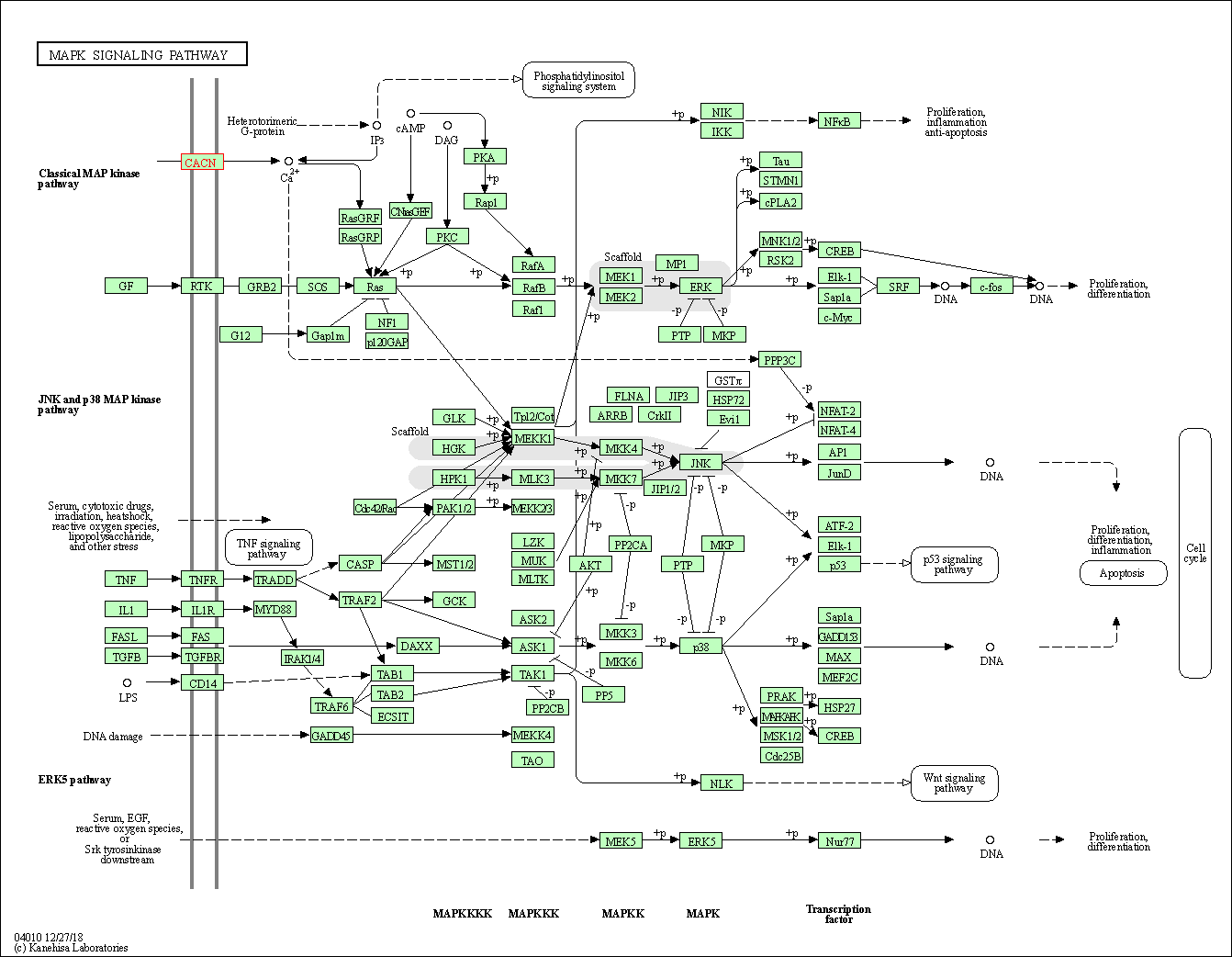
|
| Class: Environmental Information Processing => Signal transduction | Pathway Hierarchy | ||
| Calcium signaling pathway | hsa04020 | Affiliated Target |

|
| Class: Environmental Information Processing => Signal transduction | Pathway Hierarchy | ||
| cGMP-PKG signaling pathway | hsa04022 | Affiliated Target |
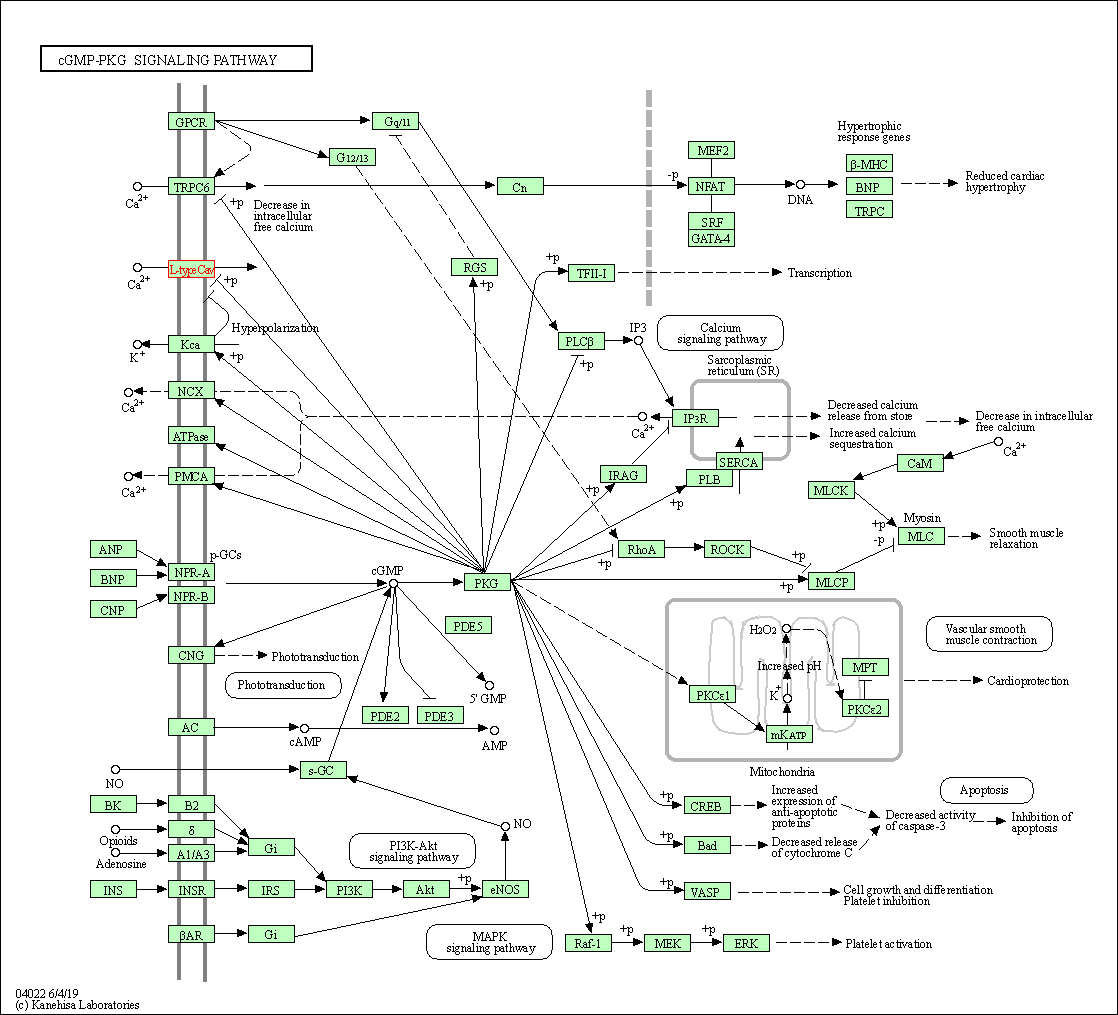
|
| Class: Environmental Information Processing => Signal transduction | Pathway Hierarchy | ||
| cAMP signaling pathway | hsa04024 | Affiliated Target |
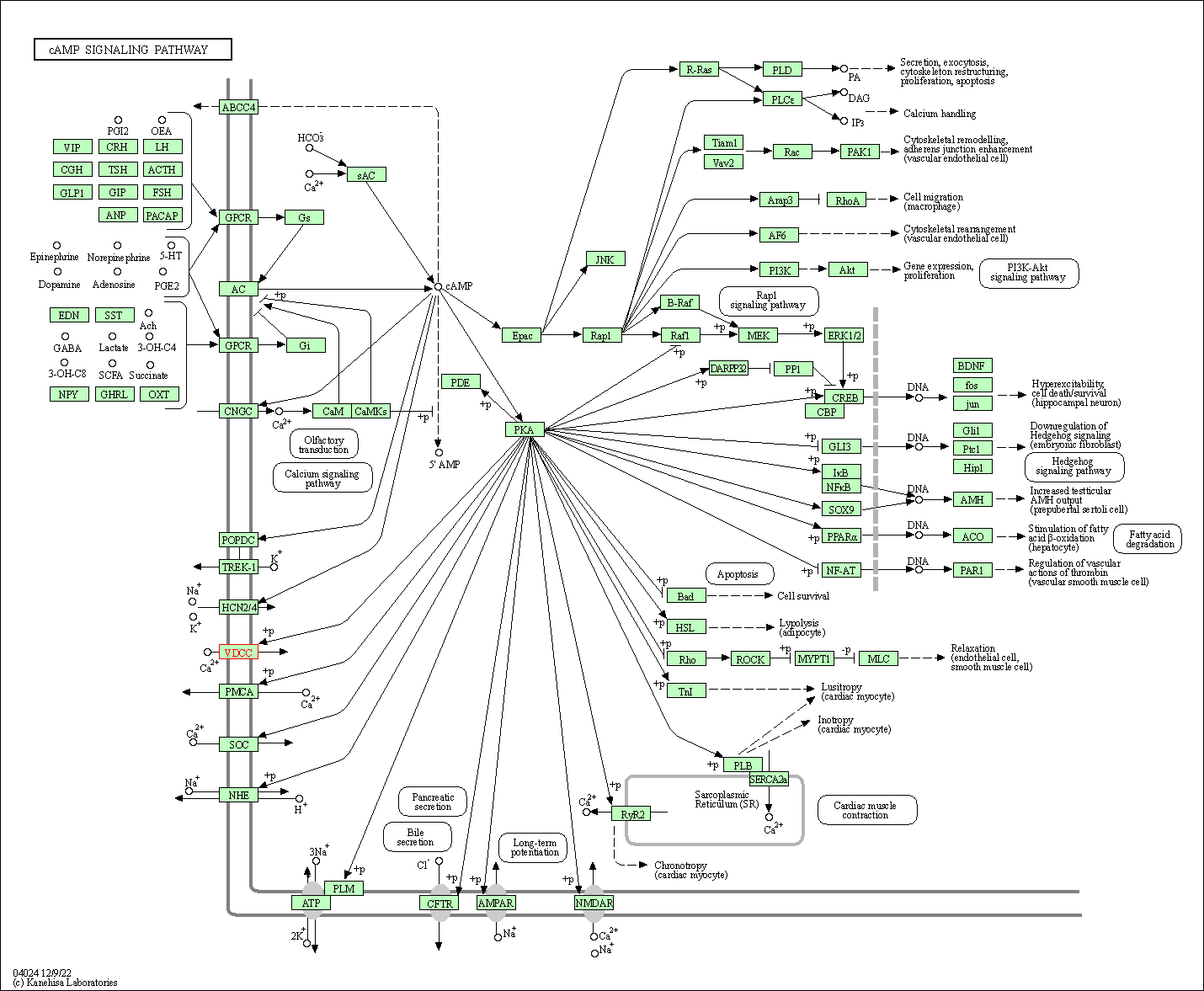
|
| Class: Environmental Information Processing => Signal transduction | Pathway Hierarchy | ||
| Cellular senescence | hsa04218 | Affiliated Target |
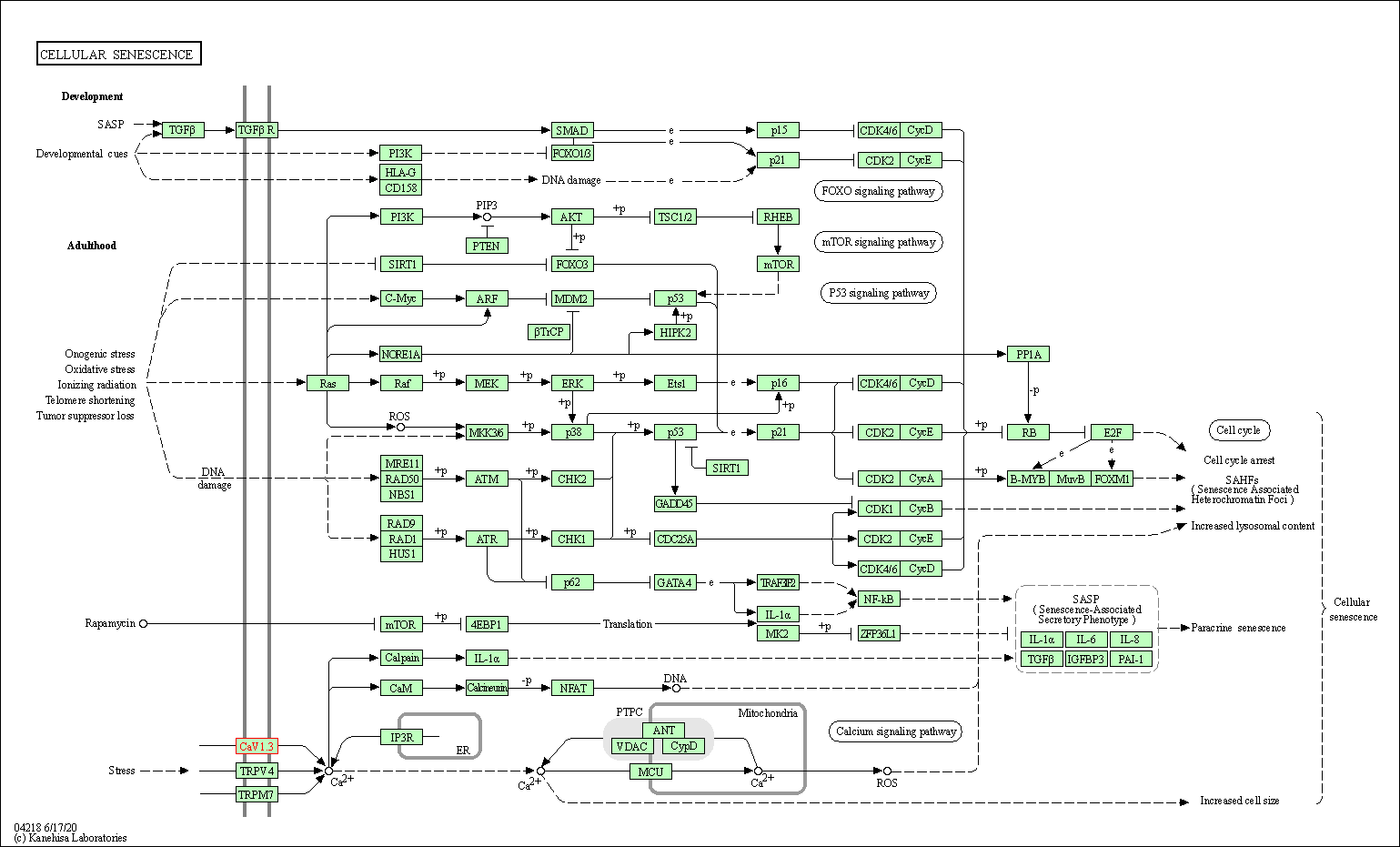
|
| Class: Cellular Processes => Cell growth and death | Pathway Hierarchy | ||
| Cardiac muscle contraction | hsa04260 | Affiliated Target |
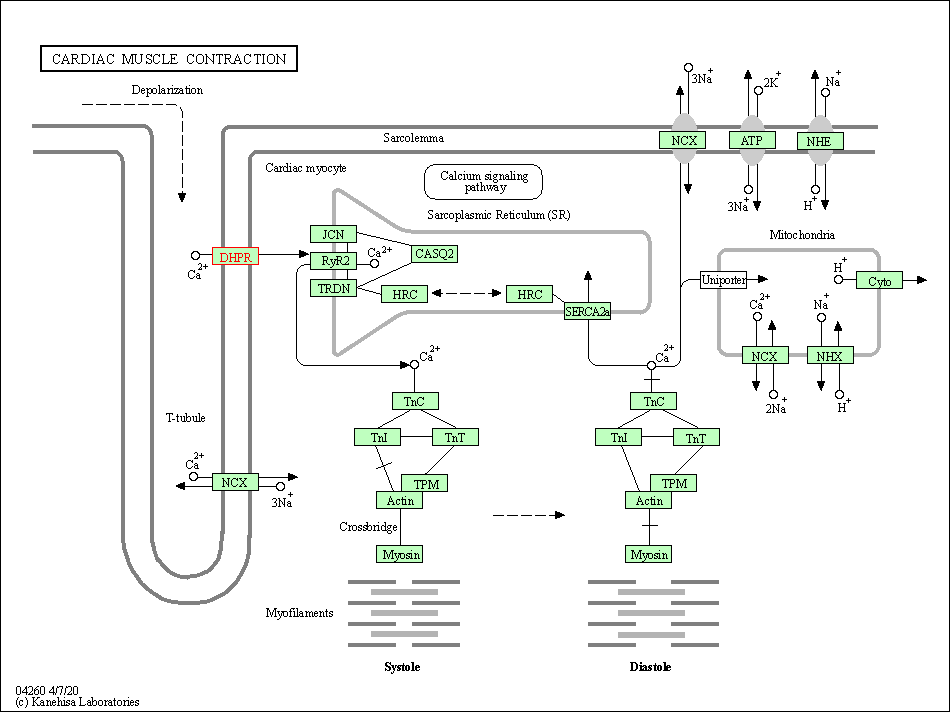
|
| Class: Organismal Systems => Circulatory system | Pathway Hierarchy | ||
| Adrenergic signaling in cardiomyocytes | hsa04261 | Affiliated Target |
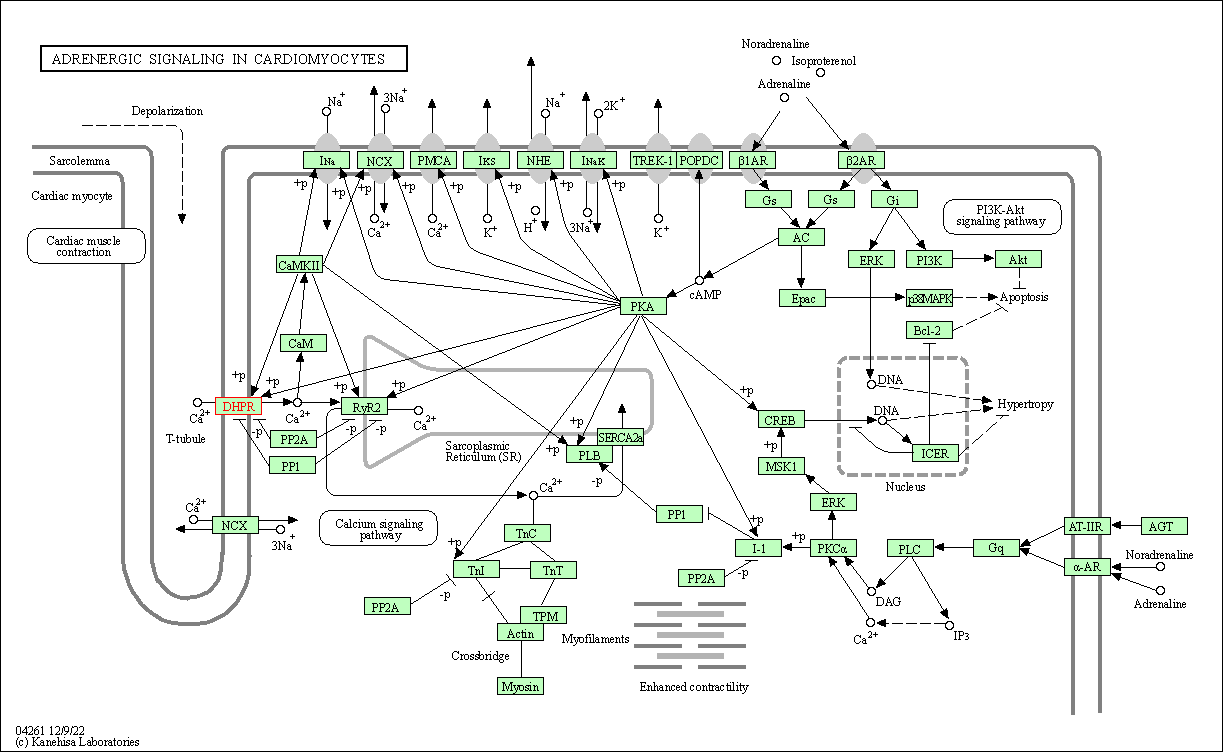
|
| Class: Organismal Systems => Circulatory system | Pathway Hierarchy | ||
| Vascular smooth muscle contraction | hsa04270 | Affiliated Target |
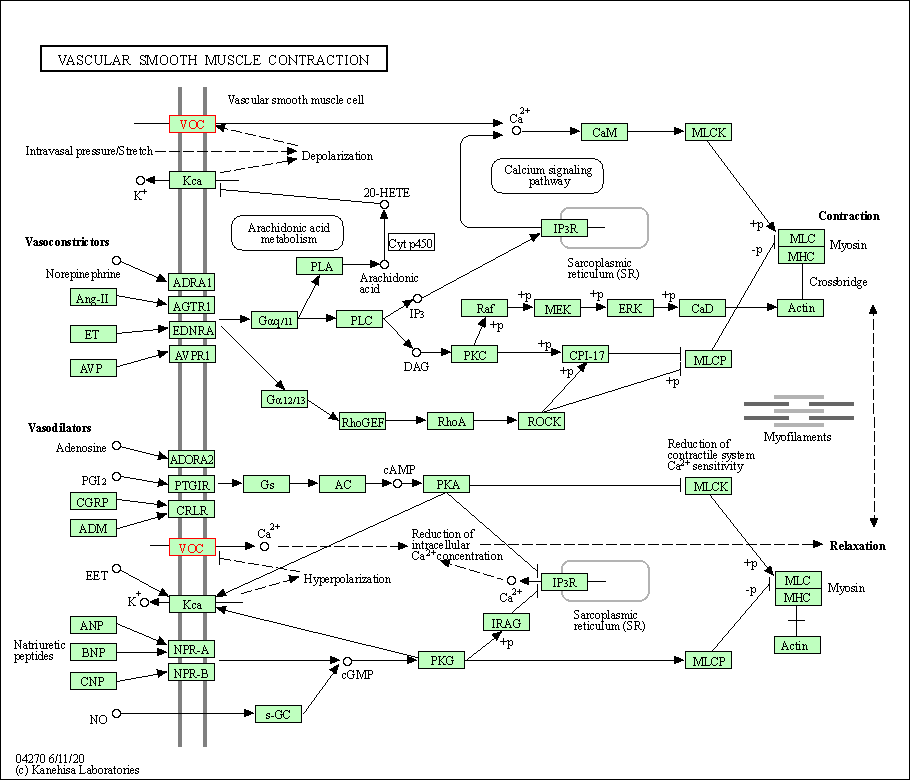
|
| Class: Organismal Systems => Circulatory system | Pathway Hierarchy | ||
| Tight junction | hsa04530 | Affiliated Target |
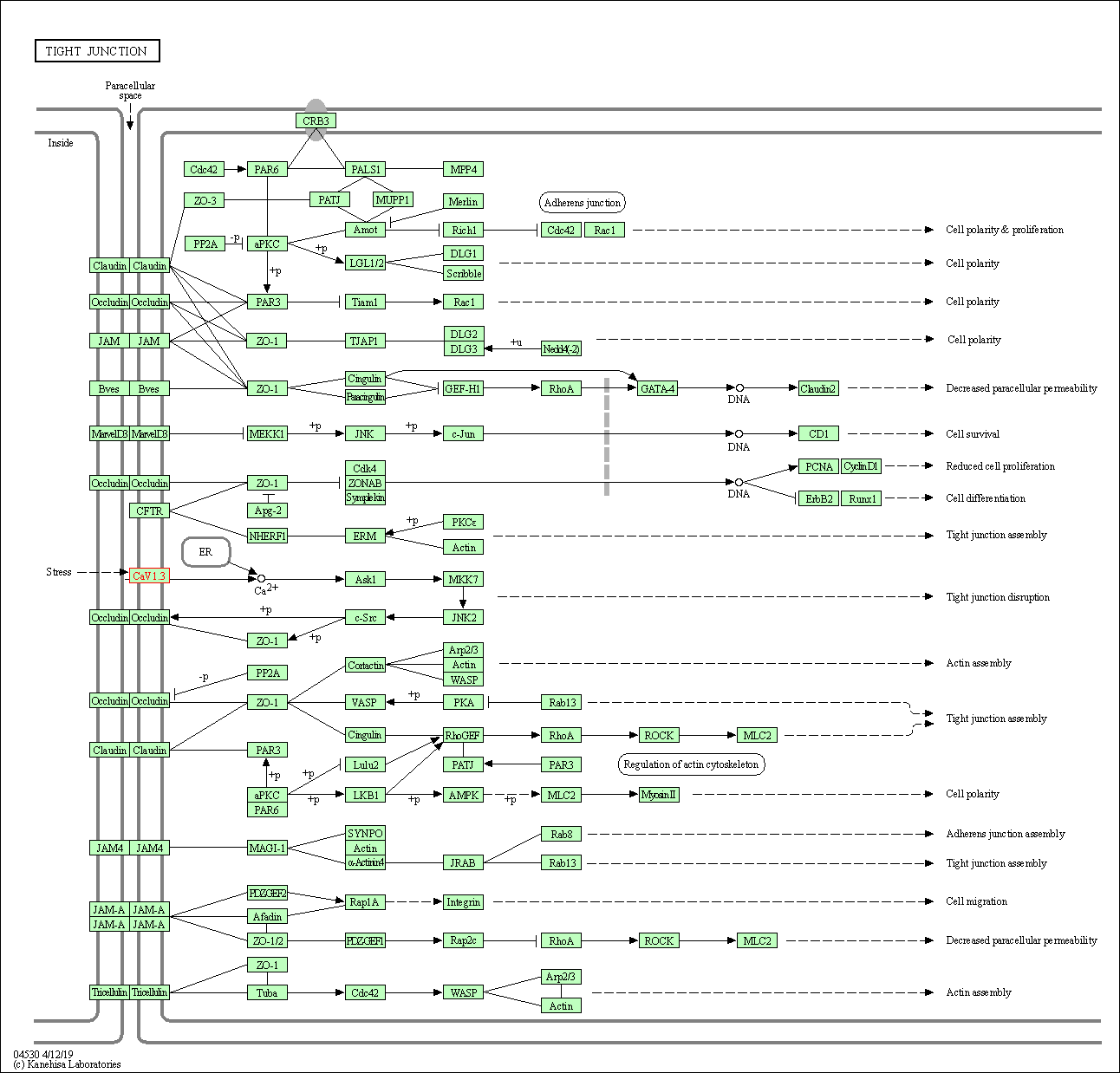
|
| Class: Cellular Processes => Cellular community - eukaryotes | Pathway Hierarchy | ||
| Circadian entrainment | hsa04713 | Affiliated Target |
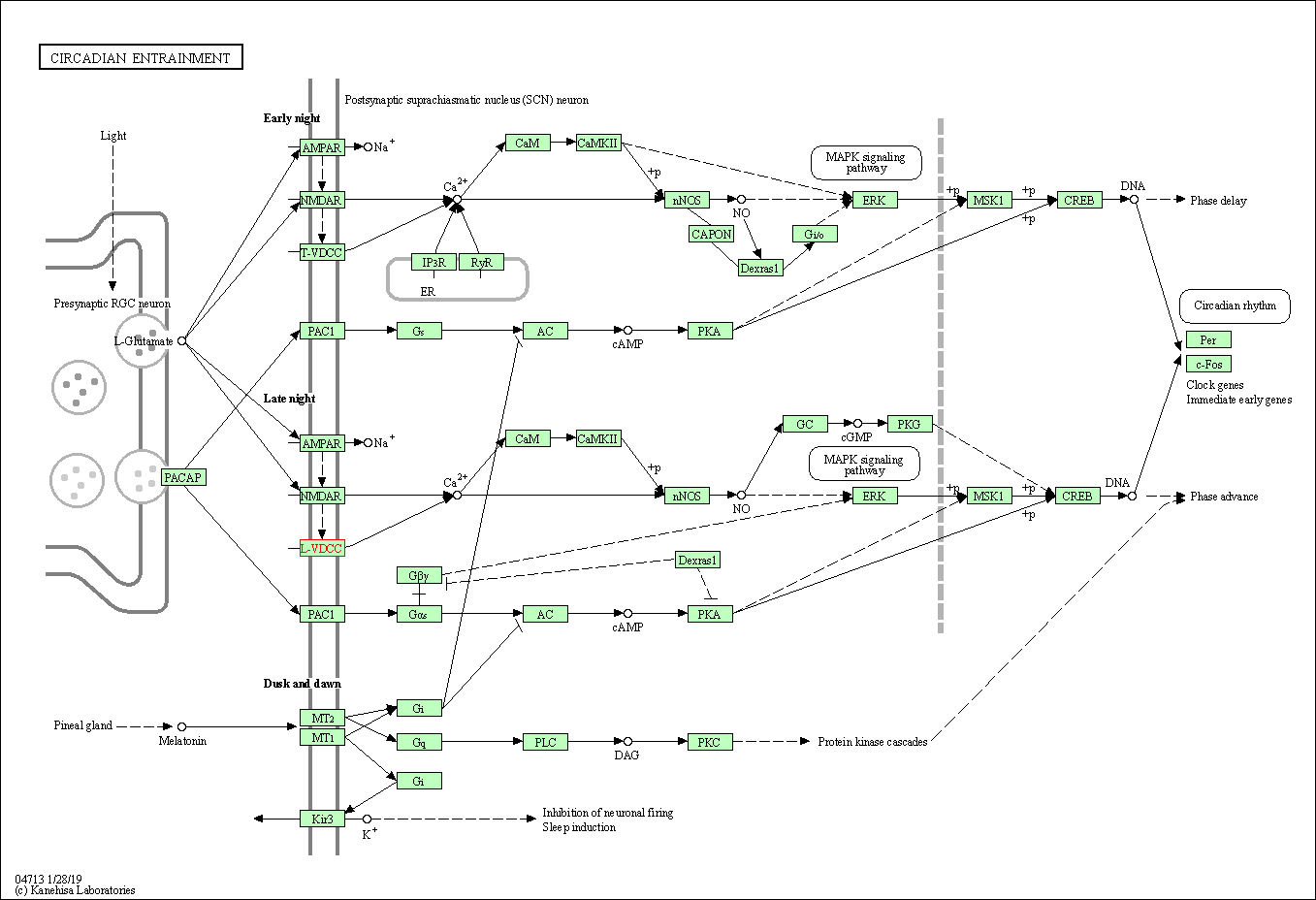
|
| Class: Organismal Systems => Environmental adaptation | Pathway Hierarchy | ||
| Retrograde endocannabinoid signaling | hsa04723 | Affiliated Target |
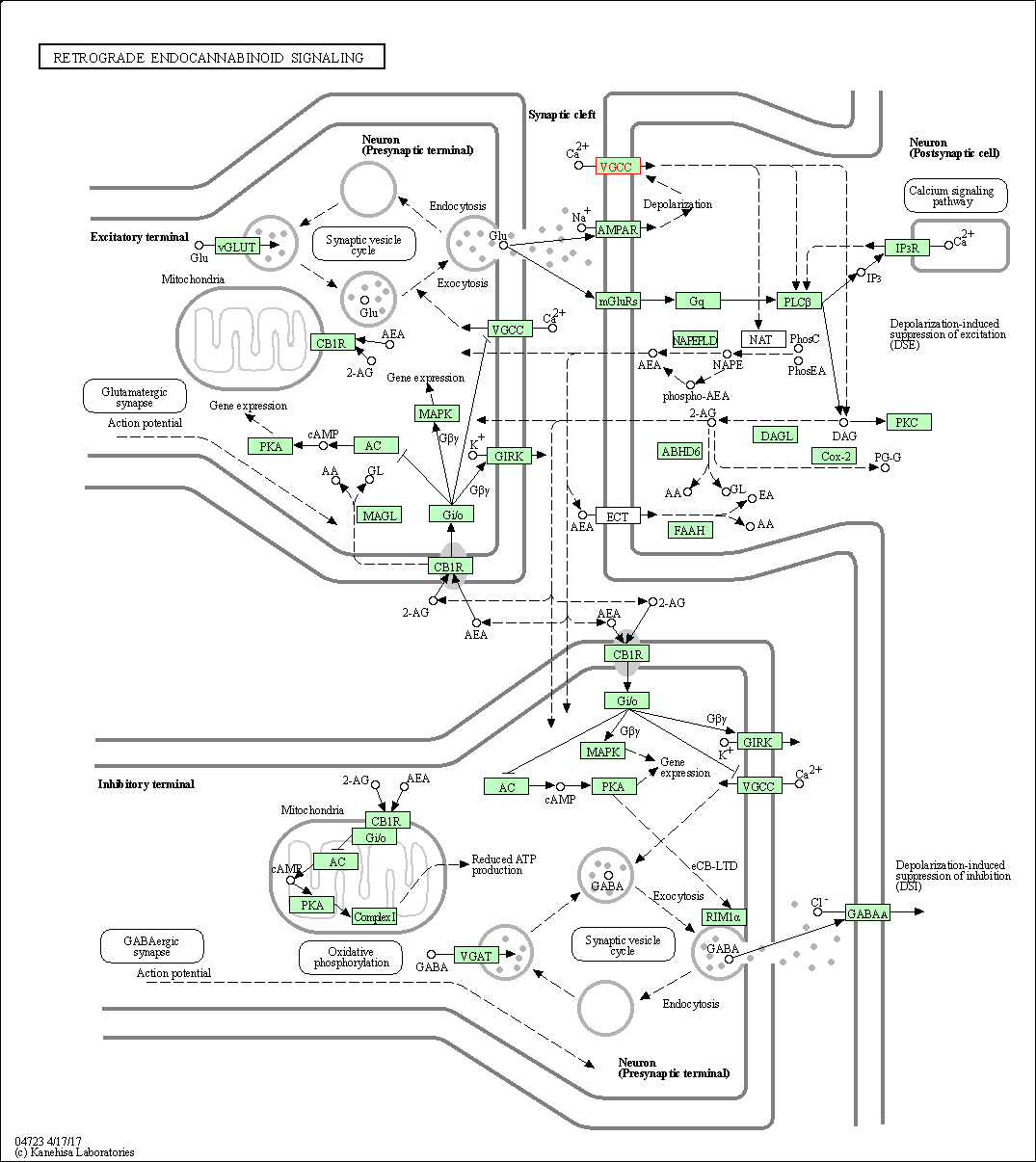
|
| Class: Organismal Systems => Nervous system | Pathway Hierarchy | ||
| Glutamatergic synapse | hsa04724 | Affiliated Target |
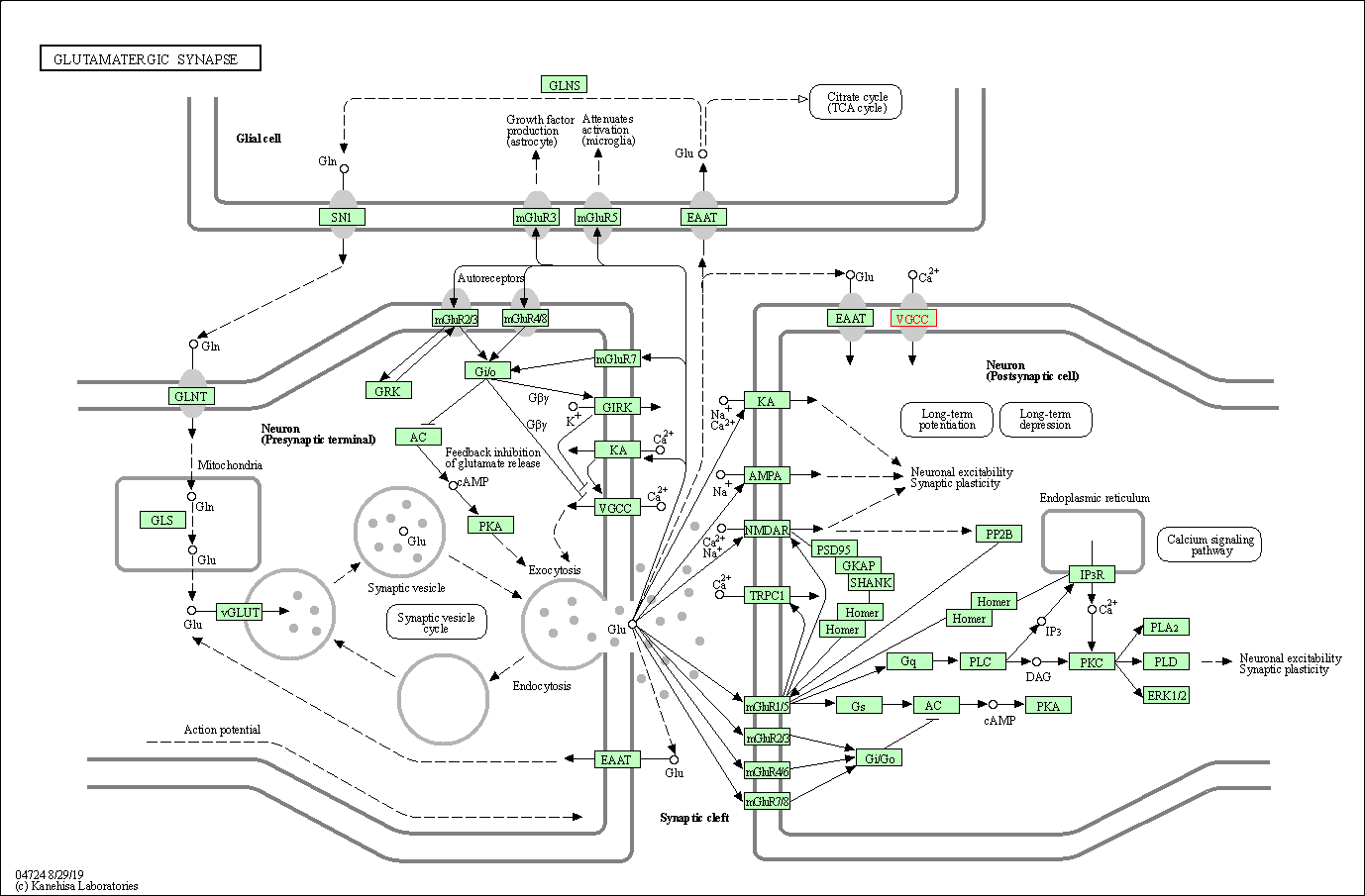
|
| Class: Organismal Systems => Nervous system | Pathway Hierarchy | ||
| Cholinergic synapse | hsa04725 | Affiliated Target |
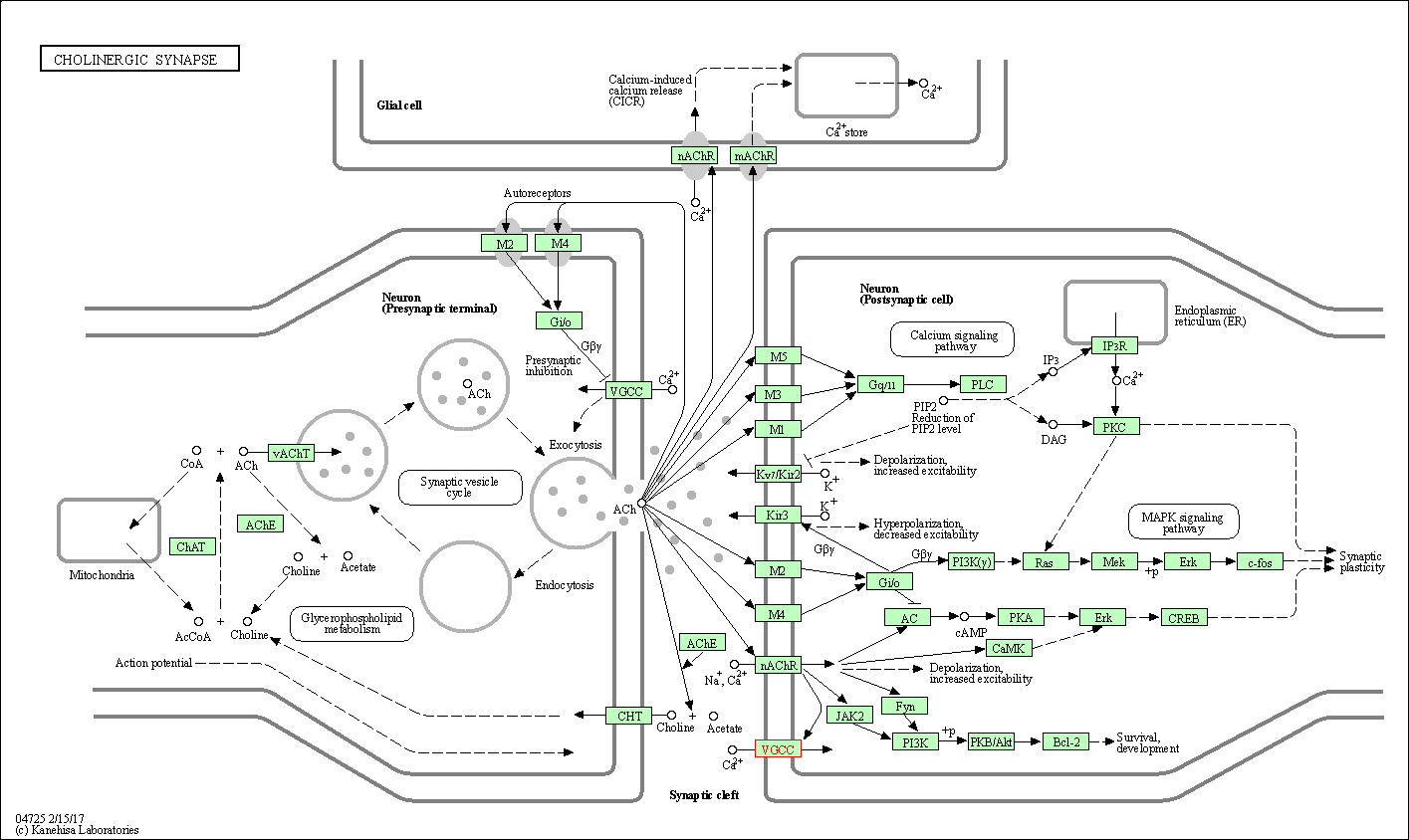
|
| Class: Organismal Systems => Nervous system | Pathway Hierarchy | ||
| Serotonergic synapse | hsa04726 | Affiliated Target |
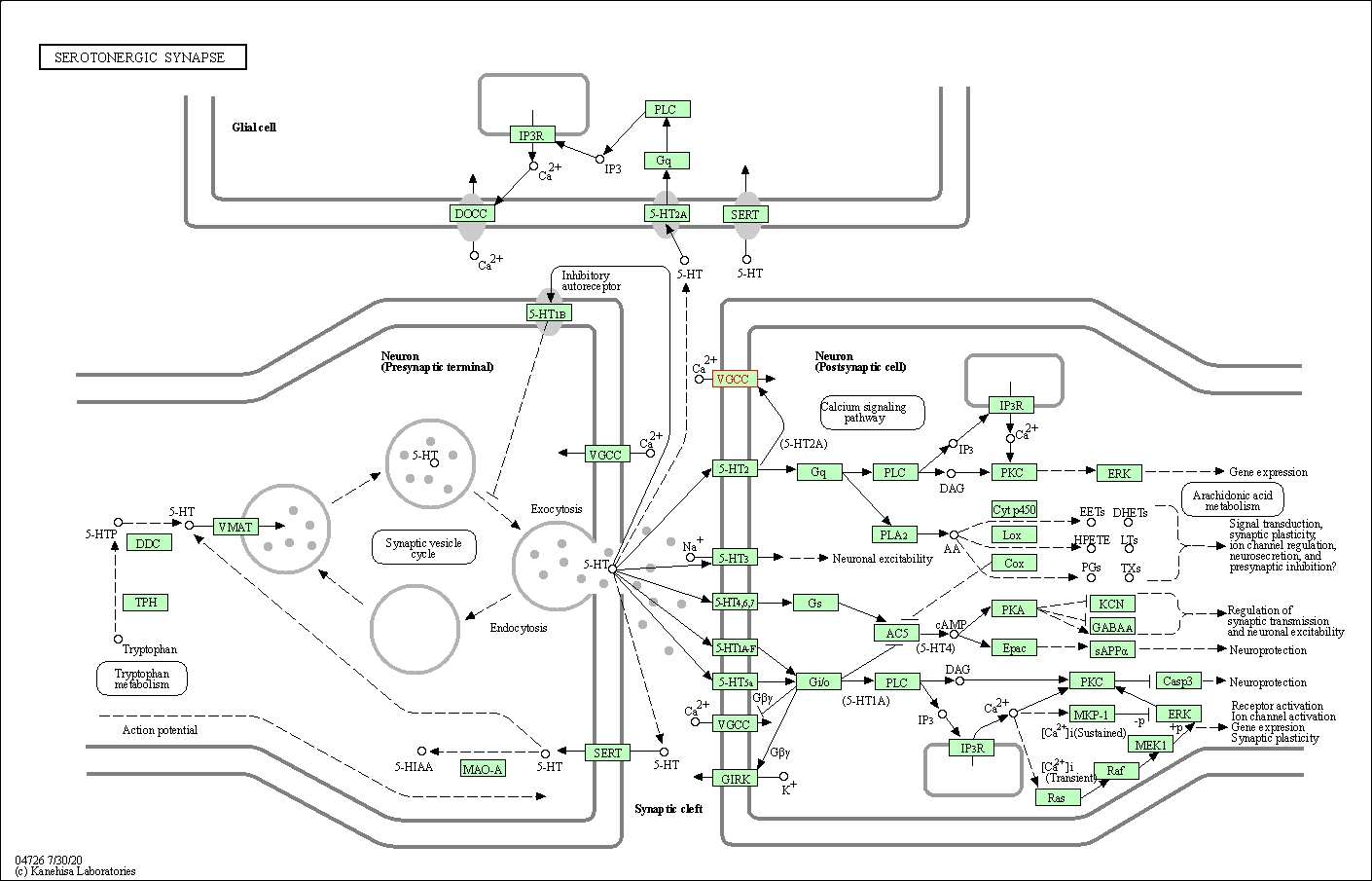
|
| Class: Organismal Systems => Nervous system | Pathway Hierarchy | ||
| GABAergic synapse | hsa04727 | Affiliated Target |
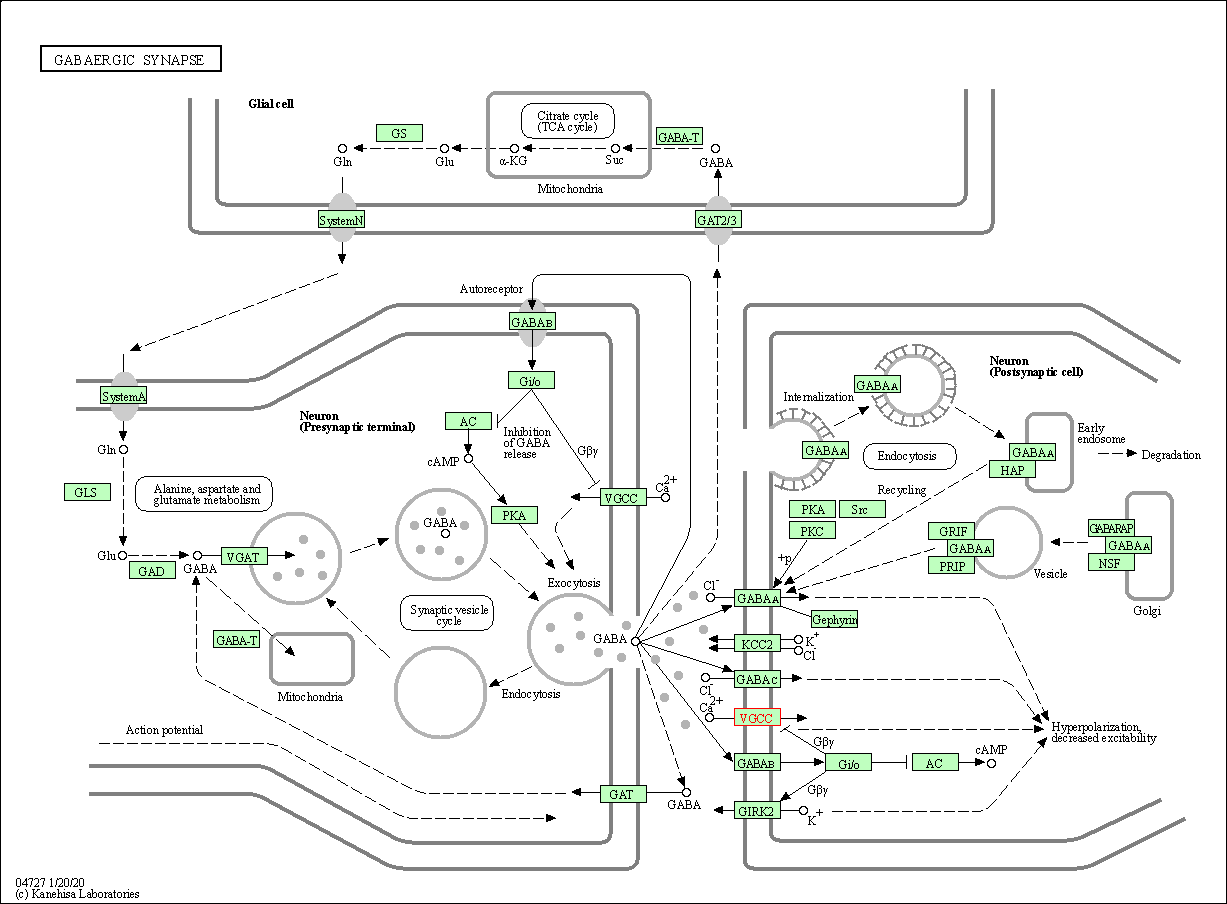
|
| Class: Organismal Systems => Nervous system | Pathway Hierarchy | ||
| Dopaminergic synapse | hsa04728 | Affiliated Target |

|
| Class: Organismal Systems => Nervous system | Pathway Hierarchy | ||
| Insulin secretion | hsa04911 | Affiliated Target |
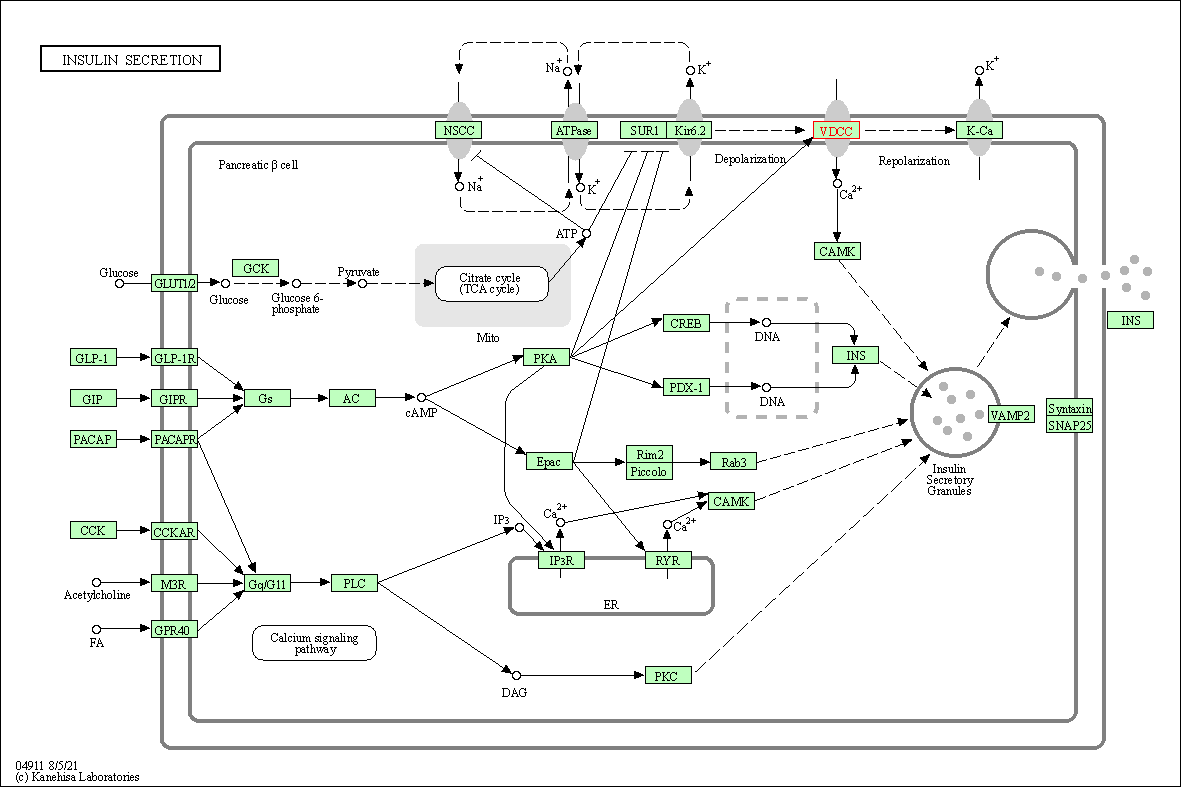
|
| Class: Organismal Systems => Endocrine system | Pathway Hierarchy | ||
| GnRH signaling pathway | hsa04912 | Affiliated Target |
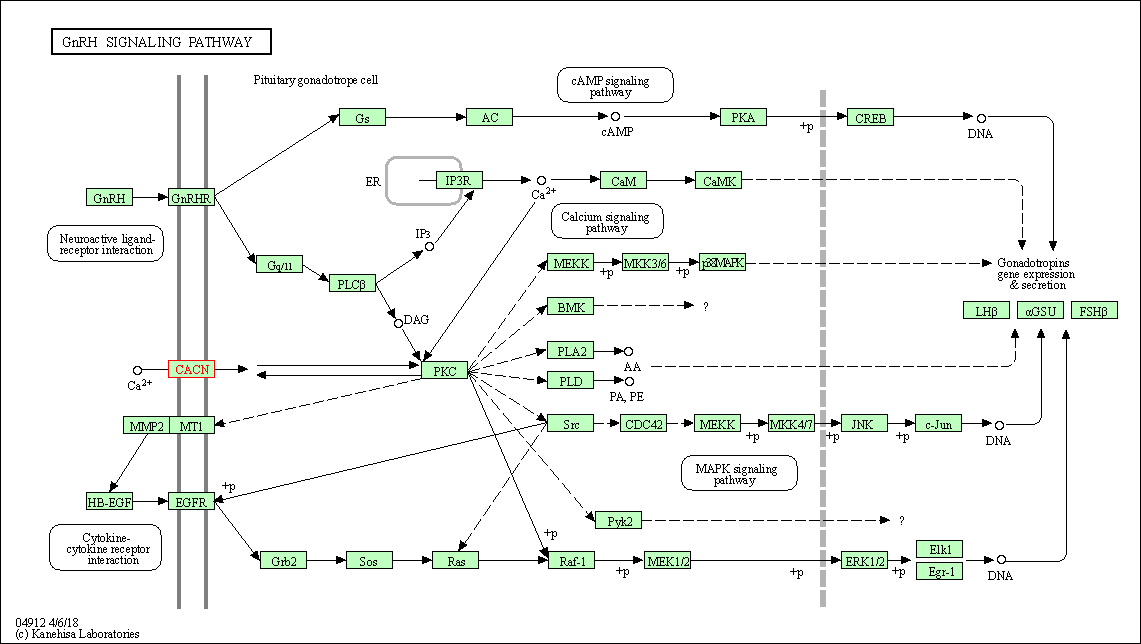
|
| Class: Organismal Systems => Endocrine system | Pathway Hierarchy | ||
| Oxytocin signaling pathway | hsa04921 | Affiliated Target |
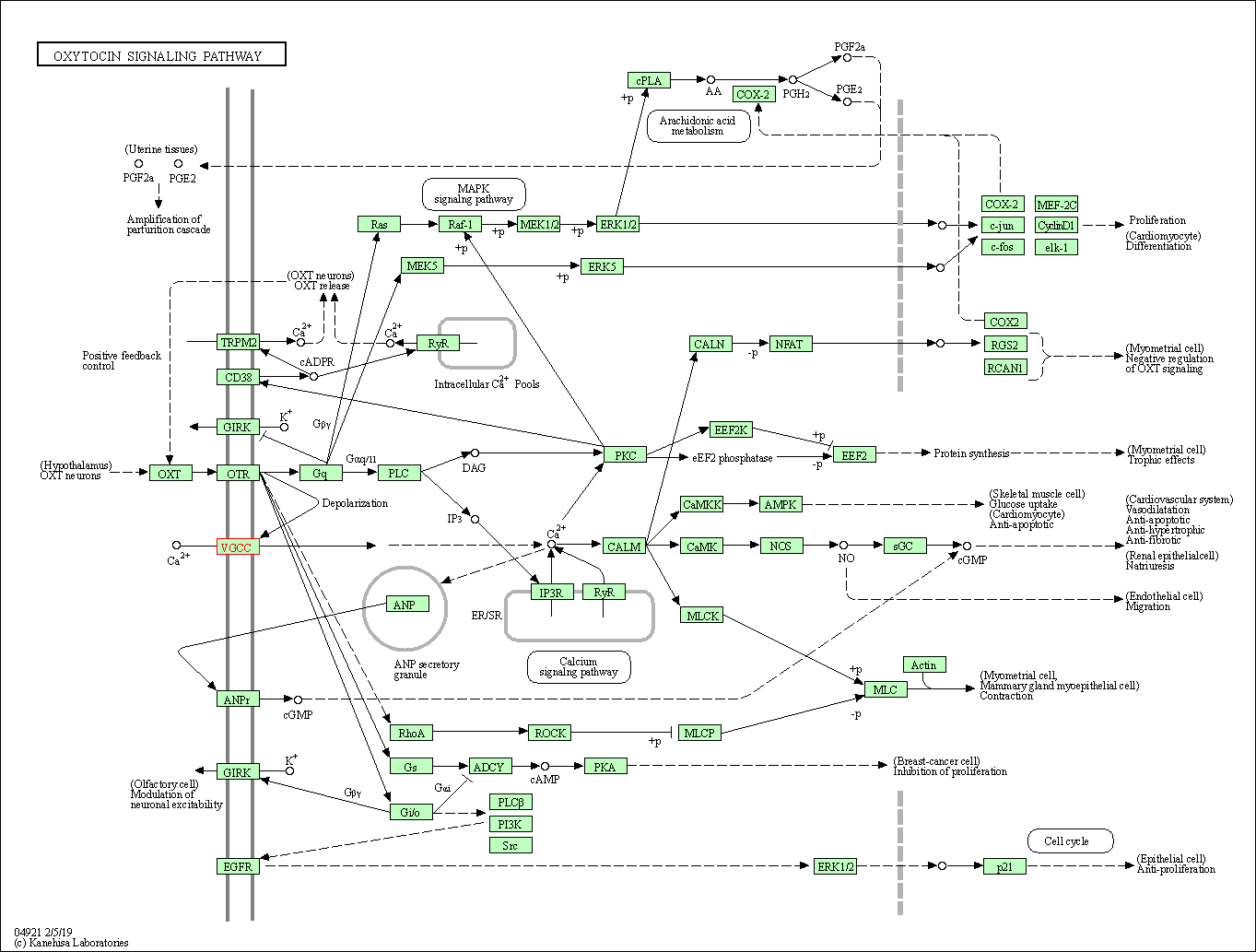
|
| Class: Organismal Systems => Endocrine system | Pathway Hierarchy | ||
| Renin secretion | hsa04924 | Affiliated Target |
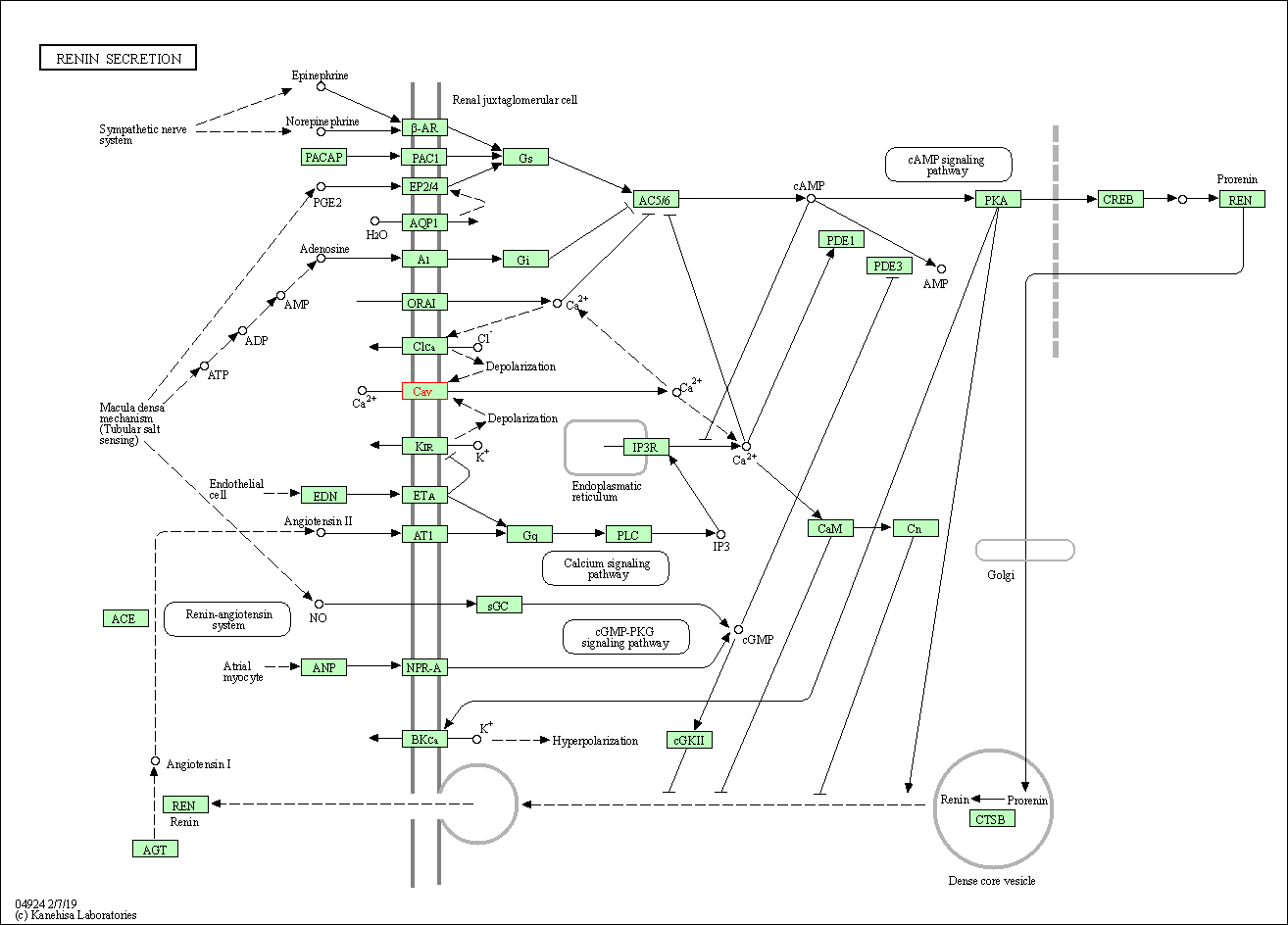
|
| Class: Organismal Systems => Endocrine system | Pathway Hierarchy | ||
| Aldosterone synthesis and secretion | hsa04925 | Affiliated Target |

|
| Class: Organismal Systems => Endocrine system | Pathway Hierarchy | ||
| Cortisol synthesis and secretion | hsa04927 | Affiliated Target |
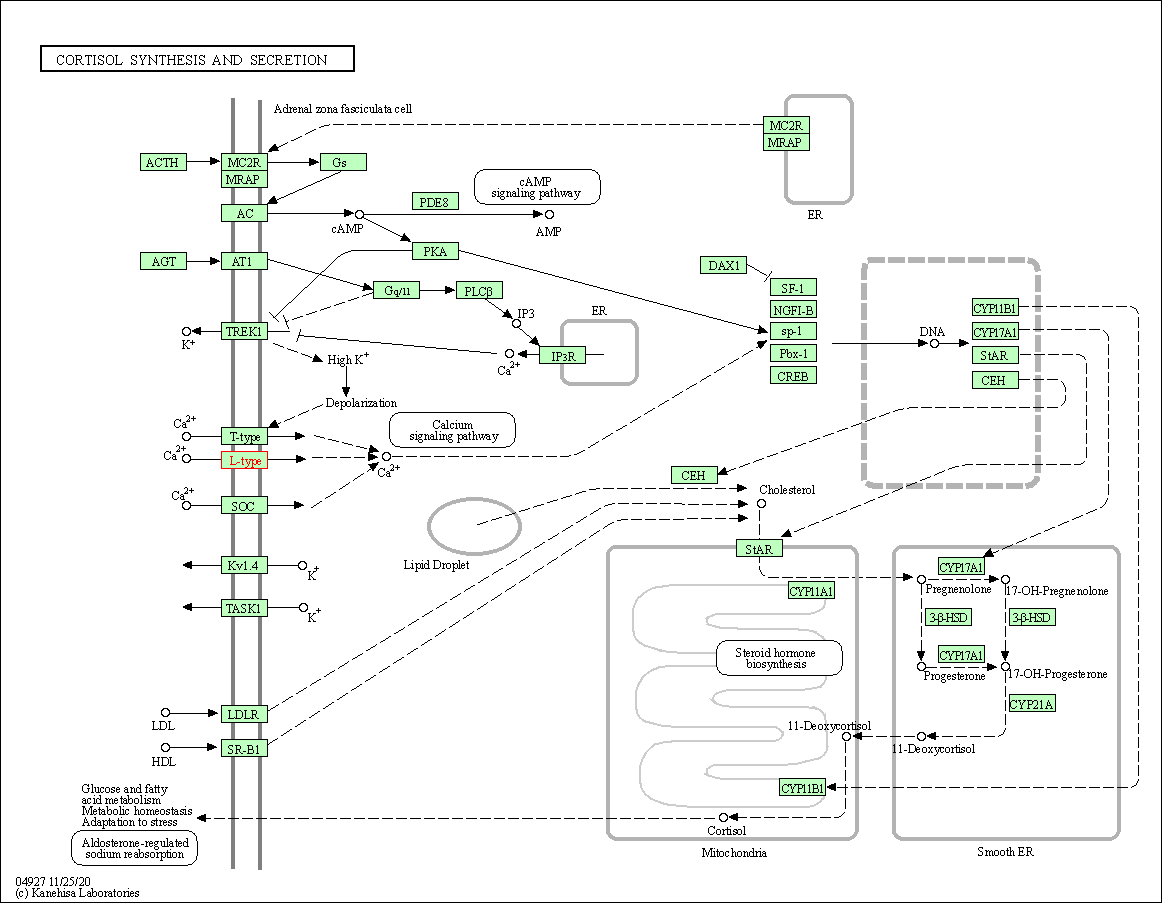
|
| Class: Organismal Systems => Endocrine system | Pathway Hierarchy | ||
| GnRH secretion | hsa04929 | Affiliated Target |
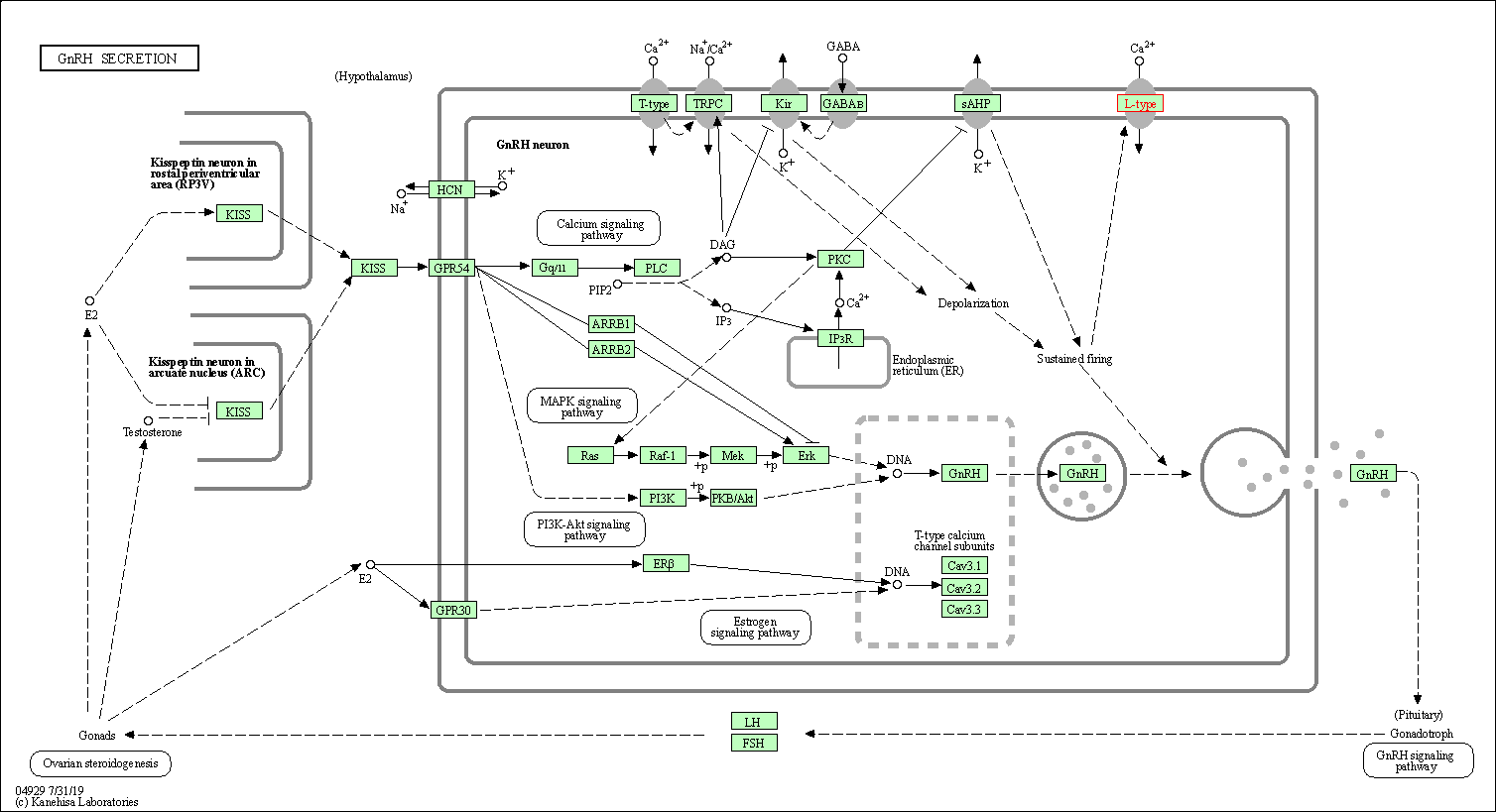
|
| Class: Organismal Systems => Endocrine system | Pathway Hierarchy | ||
| Growth hormone synthesis, secretion and action | hsa04935 | Affiliated Target |
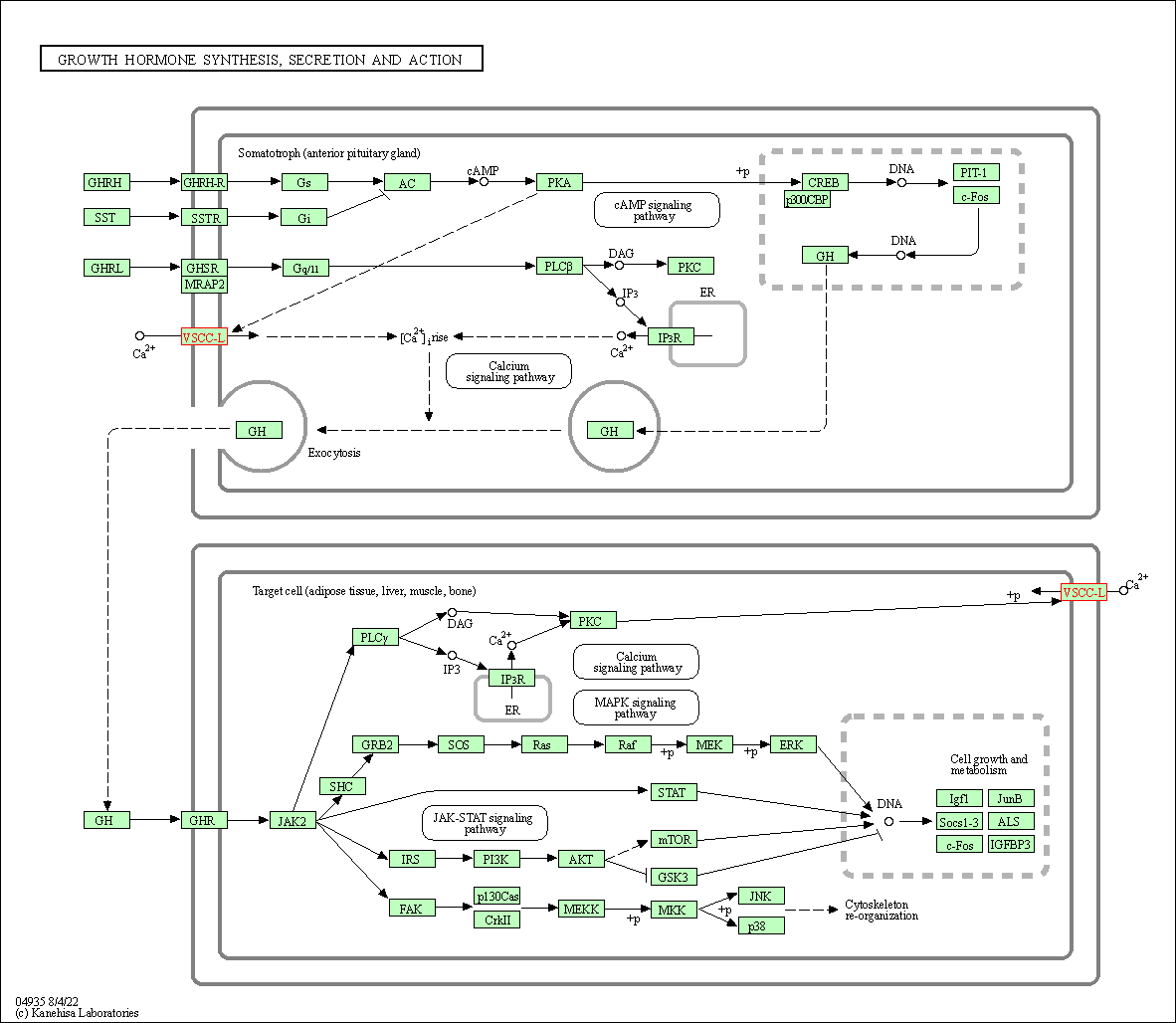
|
| Class: Organismal Systems => Endocrine system | Pathway Hierarchy | ||
| Carbohydrate digestion and absorption | hsa04973 | Affiliated Target |

|
| Class: Organismal Systems => Digestive system | Pathway Hierarchy | ||
| Click to Show/Hide the Information of Affiliated Human Pathways | |||
| Degree | 13 | Degree centrality | 1.40E-03 | Betweenness centrality | 4.19E-04 |
|---|---|---|---|---|---|
| Closeness centrality | 1.77E-01 | Radiality | 1.29E+01 | Clustering coefficient | 3.08E-01 |
| Neighborhood connectivity | 9.62E+00 | Topological coefficient | 1.56E-01 | Eccentricity | 13 |
| Download | Click to Download the Full PPI Network of This Target | ||||
| Chemical Structure based Activity Landscape of Target | Top |
|---|---|
| Drug Property Profile of Target | Top | |
|---|---|---|
| (1) Molecular Weight (mw) based Drug Clustering | (2) Octanol/Water Partition Coefficient (xlogp) based Drug Clustering | |
|
|
||
| (3) Hydrogen Bond Donor Count (hbonddonor) based Drug Clustering | (4) Hydrogen Bond Acceptor Count (hbondacc) based Drug Clustering | |
|
|
||
| (5) Rotatable Bond Count (rotbonds) based Drug Clustering | (6) Topological Polar Surface Area (polararea) based Drug Clustering | |
|
|
||
| "RO5" indicates the cutoff set by lipinski's rule of five; "D123AB" colored in GREEN denotes the no violation of any cutoff in lipinski's rule of five; "D123AB" colored in PURPLE refers to the violation of only one cutoff in lipinski's rule of five; "D123AB" colored in BLACK represents the violation of more than one cutoffs in lipinski's rule of five | ||
| Co-Targets | Top | |||||
|---|---|---|---|---|---|---|
| Co-Targets | ||||||
| Target Poor or Non Binders | Top | |||||
|---|---|---|---|---|---|---|
| Target Poor or Non Binders | ||||||
| Target-Related Models and Studies | Top | |||||
|---|---|---|---|---|---|---|
| Target Validation | ||||||
| References | Top | |||||
|---|---|---|---|---|---|---|
| REF 1 | Dihydropyrimidines: novel calcium antagonists with potent and long-lasting vasodilative and antihypertensive activity. J Med Chem. 1989 Oct;32(10):2399-406. | |||||
| REF 2 | Trusted, scientifically sound profiles of drug programs, clinical trials, safety reports, and company deals, written by scientists. Springer. 2015. Adis Insight (drug id 800031727) | |||||
| REF 3 | Trusted, scientifically sound profiles of drug programs, clinical trials, safety reports, and company deals, written by scientists. Springer. 2015. Adis Insight (drug id 800003904) | |||||
| REF 4 | URL: http://www.guidetopharmacology.org Nucleic Acids Res. 2015 Oct 12. pii: gkv1037. The IUPHAR/BPS Guide to PHARMACOLOGY in 2016: towards curated quantitative interactions between 1300 protein targets and 6000 ligands. (Ligand id: 498). | |||||
| REF 5 | Trusted, scientifically sound profiles of drug programs, clinical trials, safety reports, and company deals, written by scientists. Springer. 2015. Adis Insight (drug id 800006771) | |||||
| REF 6 | Trusted, scientifically sound profiles of drug programs, clinical trials, safety reports, and company deals, written by scientists. Springer. 2015. Adis Insight (drug id 800008159) | |||||
| REF 7 | Synthesis and characterization of N-(acenaphth-5-yl)-N'-(4-methoxynaphth-1-yl)guanidine as a glutamate release inhibitor and potential anti-ischemic agent, Bioorg. Med. Chem. Lett. 5(19):2259-2262 (1995). | |||||
| REF 8 | CGS 27830, a potent nonpeptide endothelin receptor antagonist, Bioorg. Med. Chem. Lett. 3(10):2099-2104 (1993). | |||||
| REF 9 | Discovery of alpha 1a-adrenergic receptor antagonists based on the L-type Ca2+ channel antagonist niguldipine. J Med Chem. 1995 May 12;38(10):1579-81. | |||||
| REF 10 | Trusted, scientifically sound profiles of drug programs, clinical trials, safety reports, and company deals, written by scientists. Springer. 2015. Adis Insight (drug id 800008159) | |||||
| REF 11 | URL: http://www.guidetopharmacology.org Nucleic Acids Res. 2015 Oct 12. pii: gkv1037. The IUPHAR/BPS Guide to PHARMACOLOGY in 2016: towards curated quantitative interactions between 1300 protein targets and 6000 ligands. (Target id: 530). | |||||
| REF 12 | Expression and 1,4-dihydropyridine-binding properties of brain L-type calcium channel isoforms. Mol Pharmacol. 2009 Feb;75(2):407-14. | |||||
| REF 13 | Antagonism of 4-substituted 1,4-dihydropyridine-3,5-dicarboxylates toward voltage-dependent L-type Ca2+ channels Ca V 1.3 and Ca V 1.2. Bioorg Med Chem. 2010 May 1;18(9):3147-58. | |||||
| REF 14 | Synthesis and biological activity of substituted bis-(4-hydroxyphenyl)methanes as N-type calcium channel blockers. Bioorg Med Chem Lett. 1999 Aug 16;9(16):2447-52. | |||||
| REF 15 | alpha 1D (Cav1.3) subunits can form l-type Ca2+ channels activating at negative voltages. J Biol Chem. 2001 Jun 22;276(25):22100-6. | |||||
| REF 16 | Structural basis for pore blockade of human voltage-gated calcium channel Ca(v)1.3 by motion sickness drug cinnarizine. Cell Res. 2022 Oct;32(10):946-948. | |||||
If You Find Any Error in Data or Bug in Web Service, Please Kindly Report It to Dr. Zhou and Dr. Zhang.

